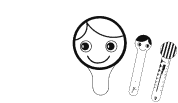|
Oculomotor Functions and Accommodation |
 |
Oculomotor motor functions, fixation, following and saccades are examined in the beginnig of each assessment. The Heidi fixation targets were designed for standardization of the test situation. It is now possible to easily define the size of the fixation target and the distance where the child can fixate and follow it. Often it is advisable to compare fixation at a penlight and at a small picture. A child/adult person may have central steady fixation on penlight but unsteady and/or extrafoveal fixation to the pictures of a bunny and a giraffe on the Heidi Fixation Stick.
Accommodation is a motor function that is often forgotten in the assessment of infants and children. It is assumed that they have normal accommodation although it should be known that accommodation may be poor in visually impaired children and children with other motor disorders, especially cerebral palsy.
In infants and young children accommodation can be measured only by using objective technique of dynamic retinoscopy. If a child seems to have difficulties in shifting the focusing to a near target (= you do not see convergense and pupils do not become smaller = miosis) it is worth while to place a plus 3-4 dioptre reading spectacles in front of the childs eyes. If you then notice convergence and miosis, if is likely but not proven that there was also some accommodation because these three functions get their innervaion from a small nucleus in front of the third cranial nerve. In the examinaton of older children you can then use visual acuity tests to assess accommodation. If visual acuity at distance is better than visual acuity at near because of poor accommodation, the use of reading addition increases visual acuity at near. There does not need to be total lack of accommodation. Often the problem is in sustaining exact accommodation for longer periods of time. Some children with CP have spastic, jerky accommodation especially when their head turns backwords.
Speed of accommodation is easy to measure and important when comparing the use of the dominant versus the amblyopic eye. The child is asked to look at a symbol on the line just above the threshold on the distance test and not to answer by saying but by pointing to the same symbol on the near vision card, again on a line just above the threshold. This way the child is gently forced to accurately change focus from distance to near and back in order to be able to point on the right symbol on the near card. The speed of accommodation in the dominant eye is compared with the speed of accommodation of the amblyopic eye. Often the speed of accommodation is slower in the previously amblyopic eye at the time when visual acuity values are symmetric.
Some children may also have less exact saccades during reading with the amblyopic eye and thus slower reading speed and more errors. These simple test situations make it possible to observe the improvement of visual functions of the amblyopic eye at home or at school.
Paediatric Vision Tests I Vision Tests I Instructions Section I Main Page
Edited in August 2009.